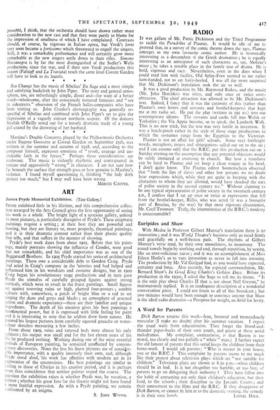ART
James Pryde Memorial Exhibition. (Tate Gallery.)
PRYDE exhibited little in his lifetime, and this comprehensive collec- tion arranged by the Arts Council gives the first opportunity of seeing his work as a whole. The bright light of a spacious gallery, unkind to most pictures, is particularly disruptive of Pryde's. These enigmatic paintings require a setting ; at their best they are powerful and moving, but they are literary or, more properly, theatrical paintings, and it is their dramatic content rather than their plastic quality that tells, and that suffers in the manner of showing.
Pryde's best work dates from about 1905. Before that his paint- ings, mainly portraits showing the influence of Conder, were good but not remarkable, and his chief importance was as one of the Beggarstaff Brothers. In 1905 Pryde started his series of architectural paintings. These owe a considerable debt to Gordon Craig. Pryde had acted in Craig's company in the 'nineties and had helped and influenced him in his woodcuts and costume designs, but in 19oo Craig began his revolutionary stage productions and in turn gave Pryde the stimulus of carefully grouped figures against strong verticals, which were to result in the finest paintings. Small figures set against towering ruins or high, plumed four-posters ; sombee colours with, somewhere, a patch of bright blue or a red to set singing the duns and greys and blacks ; an atmosphere of arrested action and dramatic expectancy—these are their familiar and unique Ingredients. The depth of his emotion gives his best paintings a montmental power, but it is expressed with little feeling for paint and it is interesting to note that he seldom drew from nature. He painted his largest pictures from carefully squared gouache or water- cjlour sketches measuring a few inches.
From about 1909, ruins and tattered beds were almost his only subjects ; his output was small and for the last eleven years of his life he produced nothing. Working during one of the most eventful periods of European painting, he remained unaffected by contem- porary discoveries. None the less his finest pictures are of consider- able importance, with a quality intensely their own, and, although l'ryde stood aloof, 'his work has affinities with modern art in its exploration of the unconscious. His best paintings are similar in feeling to those of Chirico in his creative period, and it is perhaps more than coincidence that neither painter stayed the course. The question the exhibition raises is whether Pryde was, by vocation, a painter ; whether his great love for the theatre might not have found 3 more fruitful expression. As with a Pryde painting, we remain :anfronted by an enigma. S. JOHN WnrtnS.














































 Previous page
Previous page